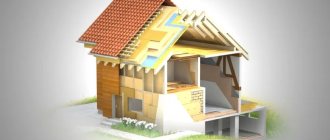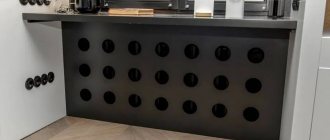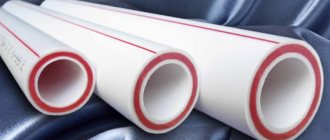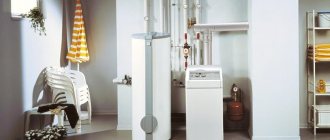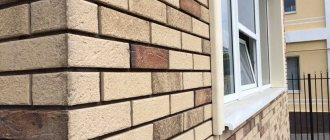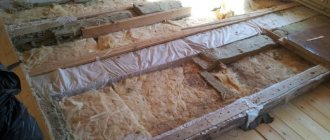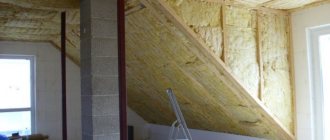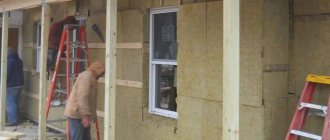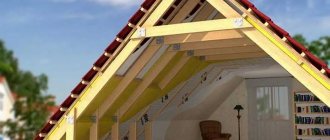For the fire safety of substances and materials, flammability properties play a decisive role. In this regard, all known compositions are divided into flammable and non-flammable. These terms define their ability to ignite. Based on this quality of materials, it is possible to calculate in advance the optimal option for fire protection of a structure at the design stage. Which materials are non-flammable and which are prone to rapid ignition can be calculated with great accuracy at the preliminary stage of construction.
What is fire resistance of materials
Flammability should not be equated with fire resistance. Fire resistance means the ability of a building structure or material to resist the effects of fire and water in a fire.
The fire resistance limit is the time in minutes (in some cases, hours) from the start of a fire until the structure fails or warms up until the temperature on the surface opposite the fire rises to about 220°C, above which spontaneous ignition of organic materials is possible.
By structural failure we mean:
- Loss of bearing capacity.
- Collapse.
- Achieving irreversible deformations
- Formation of through cracks.
The fire resistance limit of wooden house elements is 15-20 minutes, steel frame ~ 30 minutes.
Combustible building materials are divided into:
| By flame spread over the surface | According to the toxicity of combustion products | ||
| G1 | Low flammable | T1 | Low risk. |
| G2 | Moderately flammable (organomineral materials) | T2 | Moderate danger. |
| G3 | Normally flammable | T3 | Highly dangerous. |
| G4 | Highly flammable (organic materials) | T4 | Extremely dangerous. |
Non-flammable materials include mineral materials: natural stones, concrete and mortars with mineral binders, ceramic and glass materials, metals.
Materials based on organic, plant components are normally and highly flammable . These include chipboard panels, fiberboard, and most synthetic plastic materials.
Low-flammable and moderately flammable are some organomineral materials that do not support combustion: fiberboard, wood concrete, wood impregnated with fire retardants. When exposed to open fire, they smolder, do not give open fire or become charred. Once the source of fire is eliminated, smoldering stops.
When exposed to fire, some organic materials do not produce an open flame, but sinter, melt and saturate the atmosphere with a number of gases harmful to human health. When burned, wood and polystyrene foam emit two types of gases (CO - carbon monoxide, CO2 - carbon dioxide), and plastics - phenol, aluminum oxide, sulfur and other harmful substances.
This is interesting: Fireproof cutting of chimney and stove indents: Standards
How fire danger is measured
Methodological materials on life safety
According to GOST standards on the fire hazard of materials, all products for construction are divided into several categories. There are only two main groups: combustible (G) and non-combustible (NG) materials. Non-combustible products (natural stone, cement, glass) do not smolder or burn, therefore they are considered as a single group. But materials from category “G” are divided into subgroups according to a number of characteristics:
- Flammability (four groups from G1 to G4);
- Speed of fire spread over the surface of the material (RP1-RP4);
- Flammability (B1-B3);
- Smoke formation (D1-D3);
- Toxicity (T1-T4).
Materials marked G4, E4, D3 and RP4 are the most dangerous in a fire - they quickly flare up and completely burn out, releasing acrid smoke and harmful toxins that can cause poisoning or death.
Foam glass is a non-flammable thermal insulation material
Foam glass blocks are made from glass powder that has undergone a sintering process. The chemical composition of foam glass is identical to the composition of classic glass and includes oxides of silicon, calcium, sodium, magnesium, and aluminum.
Foam glass
Foam glass is a completely non-flammable material. It contains no oxidizing or organic components. When foam glass is heated to high temperatures, it only melts (like ordinary glass) without releasing gases or vapors.
The service life of foam glass blocks while maintaining their protective characteristics is more than 100 years.
Non-flammable wallpaper for walls
Fiberglass wallpaper (glass wallpaper) has fire-resistant properties. The fibers are made from quartz sand, soda, dolomite and lime.
Glass wallpaper
Non-combustible glass wallpaper is intended for finishing all types of buildings and has the following properties:
- The wallpaper is environmentally friendly.
- Convenient to use.
- Does not absorb foam.
- Wallpaper can be washed.
- Material made from fibers perfectly absorbs deformation forces (for example, from plaster).
Using a special self-adhesive tape in the seams when painting, you can completely eliminate the visibility of the seams.
Fiberglass wallpaper is available in both white and colored. They may differ in density, strength, texture and pattern.
Fireproof mineralite slabs
This material is characterized by high heat resistance and is made only from environmentally friendly substances:
- white/gray cement - up to 90% of the total material;
- mineral fibrous materials;
- Fibers reinforcing the slabs - give the slabs durability and strength.
The composition does not contain asbestos fibers, making these fire-resistant high-temperature boards suitable for home ovens. The slabs are quickly mounted on the wall using screws to the wall itself. To ensure higher reliability of the structure, you can install two sheets of minirite.
When installing, you need to leave a small distance, because When heated, the material may expand slightly.
Wall finishing with fire-resistant mineralite slabs
Fire-resistant vermiculite boards for walls, roofs and chimneys
Vermiculite boards are fire-resistant materials and have the following properties:
- They are chemically neutral.
- They are inert and do not have alkaline impurities.
- Not subject to corrosion.
- Can be processed with conventional paints and adhesives.
- They do not require any protective measures during installation and operation.
- In fire conditions they do not emit toxic or other harmful substances.
Vermiculite slabs
Such slabs are made by hot pressing from a composition based on calcined expanded vermiculite, liquid glass and inorganic targeted additives, which in the event of a fire provides the highest degree of fire protection for any structures (including metal ones).
During the firing process, vermiculite can increase its volume by 10–15 times. After cooling, the material retains its acquired shape.
Scope of application of vermiculite:
- Fire protection for load-bearing metal structures and air ducts with a fire resistance limit of 0.75-2.5 hours.
- Fire protection of wooden, including load-bearing building structures with a fire resistance limit of 0.75-2.5 hours.
- Increasing the fire resistance of metal air ducts, shafts, casings, sleeves, cable ducts, fire barriers.
- Used in the manufacture of fireproof doors, valves, safes, partitions and suspended ceilings
- It is used for structural thermal protection and fire protection of chimneys during the installation of fireplaces, stoves and other energy equipment.
Fire retardant efficiency group, depending on the thickness of the vermiculite: group 1 (at least 150 minutes) with a material thickness of 48 - 50 mm; Group 2 (at least 120 minutes) with a material thickness of 32-40 mm; Group 3 (at least 60 minutes) with a material thickness of 20-25 mm.
Care Tips
In houses with stove heating, maintaining the stove and fences that protect the combustible structures of the house from overheating in good condition is the key to trouble-free living for its owners.
Fire is no joke, and there are no trifles in observing fire safety rules! If they say that a sheet of metal measuring 500x700 mm is needed in front of the furnace loading door, it should be there! Every year, before the start of the heating season, you should check the condition of the heating appliances at home. It is necessary to check whether the heat-resistant plaster of the stove is damaged, whether there are cracks in the chimney, or whether the facing tiles have fallen off. All identified defects must be corrected in a timely manner.
Mineral wool fire retardant products
Mineral wool fibers are able to withstand temperatures above 1000°C without melting. In the process, at temperatures above 250°C, the binders of the material evaporate, and the fibers, due to chaotic adhesion, provide cohesion and sufficient strength, creating protection from fire.
Mineral wool fire retardant products
Mineral wool fire-retardant materials are successfully used for insulating fireplace and stove pipes, external walls, roofs, and floors.
This is interesting: Fire and explosion hazard category of buildings: definition
Reason #6. Lack of light or direct sunlight
gardeningknowhow.com
Incorrect placement can also cause leaf tips to turn black. Moreover, both too bright light (direct sunlight) and lack of lighting lead to a similar result.
When trying to understand why the leaves of flowers dry out, it doesn’t hurt to analyze whether direct sunlight burns the plant. This provokes the appearance of not only brown tips, but also entire spots. This phenomenon occurs especially often after spraying on a sunny day.
Yellowing due to lack of light looks different. It manifests itself as an uneven loss of color and may be accompanied by the dropping of leaves (hibiscus behaves this way most often).
- Find out which window (north, east, southwest, etc.) the flower prefers to grow on, and try to find a suitable place for it.
- If it is not possible to place the pot on a bright window, get an additional lamp. This can be a special phytolamp or a regular fluorescent one.
- If the leaf tips are turning yellow on only one side of the flower, try rotating the pot from time to time to ensure all shoots receive enough light.
- Protect the plant from bright sunlight using blinds or regular cardboard (its size should correspond to the height of the flower), which should be placed between the window and the flower pot during the daytime.
Magnesium glass panels - a universal fire-resistant finishing material
Magnesium glass sheet is a finishing material based on shavings, magnesium chloride and fiberglass. It is flexible, durable, fireproof and moisture resistant.
The reinforcing fiberglass mesh in the composition allows the glass-magnesium sheet to bend with a radius of curvature of up to three meters. Thanks to this, the material is convenient to use on uneven surfaces without the risk of sheet fracture.
Magnesium glass panels
This fire-resistant material is environmentally friendly. Even when heated, it does not release toxic substances.
Resting-place
A lounge area will be conveniently located within the free space. Using high-quality finishing materials, textiles and decor, you can create a magnificent, cozy, stylish corner in which you can relax, read, chat with friends, listen to music and just dream about something. For maximum comfort, you should consider lighting modes and, possibly, provide built-in musical equipment, niches or shelves for placing books or other items, depending on the hobbies and preferences of the owners. The location next to a window with a beautiful view will make the area absolutely magical.
Even the idea of placing a mini-bedroom under the stairs is realized.
Fire retardants to improve fire resistance
Fire retardants are special substances that increase the fire resistance of initially combustible materials.
Basic requirements for fire retardants:
- Preventing combustion and smoldering of the protected material.
- Not capable of causing corrosion of metal parts.
- Ability to act over a long period of time.
- Fire retardants should not increase the hygroscopic properties of wood.
- Harmless to people and animals.
- The compositions should not affect paint coatings or create difficulties during mechanical processing of the material.
One of the best fire retardants is disubstituted ammonium phosphate (diammonium phosphate). When heated, it releases phosphorus oxides, which cover the wood with a protective film, and a non-flammable gas - ammonia. Diammonium phosphate is usually used in a mixture with ammonium sulfate.
There are two types of fire retardant compounds, which are based on fire retardants:
- For deep fire-retardant impregnation of lumber under pressure in industrial autoclave installations.
- For surface fire retardant treatment. This type includes traditional mortars used on construction sites, in attics, on roofs, and rafter systems. The method of application in this case is with paint brushes, rollers, spraying with construction spray guns in two layers with a significant drying period between layers.
A little more about laying tiles
Types of fireproof tiles
Refractory tiles for stoves, with high heat resistance, are produced by manufacturers in several versions:
- terracotta - with an unglazed surface and a highly porous structure. This type of heat-resistant tile was one of the first to appear on the market;
- majolica - with a glazed surface and a highly porous structure;
- clinker - with a fine-porous structure, characterized by increased strength;
- porcelain stoneware - the composition includes: quartz sand, metal oxides, marble and granite chips. This material is resistant to high temperatures and temperature changes, and is also environmentally friendly.
Some nuances when laying tiles
To ensure that stove tiles serve you for a long time, use special heat-resistant adhesive for stoves and fireplaces when laying them. The thickness of the adhesive composition should be 2-5 mm, otherwise the risk of cracking of even the most durable material increases significantly. The glue should not have a specific odor. If installation is carried out on metal parts, keep in mind that metal expands when heated and therefore you need to leave approximately 1 cm indentations. If the cladding of stoves is carried out outdoors, use moisture-resistant glue. Laying is carried out only on a plastered surface. The cut pieces are placed at the very end. Correct installation technique extends the life of the material.
What is the difference between heat-resistant tiles and conventional cladding?
Heat-resistant tiles for stoves and fireplaces differ from simple cladding in that they have a low water absorption coefficient (less than 3%). Thermal tiles can withstand very high temperatures, do not crack or change color. This material is resistant to severe frosts, so it is suitable for finishing stoves located in the open air. The advantage of using such cladding is also its heat transfer. Heat-resistant finish prevents flue gases from entering the surrounding area. Caring for her is quite easy and simple. The material has a variety of shades and textures, so you can easily choose the right option for any interior.
Where can ceramic tiles be used?
Ceramic tiles for stoves and fireplaces are, first of all, a decorative material that is designed to make a fireplace or stove more beautiful and create a special, unique style. The material is not used for cladding so-called working surfaces, that is, it is not used for finishing, for example, heaters (in sauna stoves) and the internal surfaces of a stove or fireplace. In the photo below you can see an example of a fireplace lined with ceramic tiles. As you can see, it is used only for decorative purposes.
What is the difference between fireclay tiles and ordinary ceramic tiles?
First of all, fireclay tiles differ from ordinary ceramic tiles in their greater thickness and variety of shapes and sizes (you can make custom-made options of any shape and any size). This material is not a mass-produced product, so it has a special appearance, characteristic of handmade products. Fireclay tiles are quite durable, heat-resistant and moisture-resistant. When broken, you can see the presence of fireclay grains in the structure, which are absent when a regular ceramic one is broken. Clinker tiles have a similar structure, but they are much denser. The price depends on the artistic execution (painting, mixing different glazes, etc.).
Are tiles suitable for lining a stove?
Not every tile is suitable for lining stoves. When choosing, keep in mind that the material will be used under conditions of constant heating and cooling. Experts say that it is better to choose small tiles for stoves and fireplaces (no more than 25x25 cm). It is advisable to choose matte-colored tiles, since over time a network of small cracks will form on the glazed surface. Tile should not be used at all if the stove is located in a country house that is not intended for permanent residence and is heated only in winter - the tile cannot withstand this regime and soon begins to crack and crumble.
Fire resistant paint
Fire retardant paint is a mixture of binder, pigment and filler. Such compositions are often prepared using potassium liquid (silicate) glass. Also included in appropriate proportions are fire-resistant fillers, white, colored pigment, potassium liquid glass and special additives. Ground vermiculite, perlite, talc, kaolin wool fibers, and fluffed asbestos are most often used as fillers.
Fire-resistant paint is capable of spontaneous hardening, and the resulting film can serve both for fire protection and for decorative purposes.
Fire-resistant paints on liquid glass are used for interior finishing work and to increase the fire resistance of wooden structures made of fiberboard (fibreboard) and chipboard (chipboard). Organosilicate compositions can be used for painting exterior elements and metal structures.
Varieties
Non-combustible building materials are classified according to several criteria. By purpose they are distinguished:
- insulators;
- for insulation;
- non-combustible finishing materials for walls, floors, and ceilings.
In addition, the products differ from each other in the way they transfer heat:
- temperature-resistant due to physical and chemical properties;
- materials that reflect heat.
By release form:
- leafy;
- panels;
- roll
By place of use:
- for interior decoration;
- for installation outside buildings and structures.
Important! In addition to the basic fire-fighting properties, fire-resistant products may have additional parameters. For example, moisture resistance allows it to be used in the kitchen, bathhouse or swimming pool. High sound absorption rates allow the material to be used for insulating music studios, cinemas and other facilities.
Fireproof fireproof panels "Gypsoacryl"
A few recommendations
When choosing fireproof insulation, first of all pay attention to the place of its application. For insulating foundations, non-mineral materials such as foam glass, polystyrene foam or polyurethane foam are more suitable.
When insulating roofs and facades of buildings, preference is given to basalt wool with a density of about 140 kg/m3.
The environmental friendliness of the material is also taken into account. If the house is still under construction, it is better to insulate the external walls with expanded clay, perlite or vermiculite. In old buildings this is not always possible, so glass wool or spray foam is used.
Properly selected insulation will protect the structure from destruction and significantly reduce the cost of heating the house in the winter months. Don't go after cheap prices. It is better to purchase high-quality materials from large companies with a good reputation. In this case, they will last for several decades and will fully cope with their functions.
Highly flammable
A group that includes materials, during combustion of which the temperature of the flue gases begins to exceed the threshold of 450 ° C. Flammability class G4 has a degree of damage to the material along the entire length of the sample of more than 85%, a degree of destruction of more than 50%, and independent combustion exceeds 300 seconds.
Additional requirements apply to flammability materials G1 and G2. When burning, they should not form melt drops. An example is linoleum. The flammability class of this flooring cannot be 1 or 2 due to the fact that it melts strongly during combustion.
Definition
Non-combustible materials include those that do not ignite under the influence of an ignition source, such as sparks, thermal heating, electric current, or chemical reactions. Natural and artificial inorganic substances are classified according to their origin. Stone blocks, concrete screeds, and reinforced concrete products are considered natural refractories.
Other essential technical requirements for fire-resistant coatings require increased values for the following parameters:
- bending strength, tensile strength;
- hygroscopicity;
- density;
- moisture resistance;
- specific viscosity;
- deformation when heated, wet;
- thermal conductivity.
Additional qualities make it possible to use raw materials for certain tasks.
Scope of application
The purpose of such facing blocks is different. Non-combustible materials are used for finishing walls and ceilings, as well as ceilings and cladding of building facades. They are also in demand for roofing installations, for example from natural tiles. Their physical properties make it possible to install fireplaces, chimneys, and other heating structures.
Note! Since residential, commercial and industrial premises are created for people, finishing materials must also meet environmental criteria and sanitary and epidemiological standards.
Many manufacturers produce product lines that are not only fireproof, but also aesthetically pleasing. Facing and finishing walls perform 2 functions, since their front surface imitates natural wood. They also produce wallpaper equipped with metallized coating and others.
Fireproof substances
Let's consider what substances and materials are non-flammable. The main types of construction consumable components with fire resistance are:
- Fabric - rolled.
- Panel.
Fabric versions of non-flammable materials
Fire-resistant fabrics are an indispensable tool for various construction activities; they are made from these types of raw materials:
- Polyesters. Their fibers are obtained by synthesizing polyester, phosphorus chemicals. Weaving threads are formed using technology from jacquard to velvet fabrics. Their mandatory properties are non-flammability, strength, resistance to ultraviolet and infrared spectrum, and environmental friendliness. When exposed to flame, it shrinks in size, but does not release toxins.
- Carbon. These synthesized fabrics contain exclusively carbon structure. They have increased resistance to fire, chemicals, stretching, deformation and temperature conditions of more than +300 o C.
- Silica and quartz fabrics have similar parameters. The first type of matter is intended for temperatures up to + 2000 o C, the second up to 1300 o C. Quartz threads form something like fiberglass. This type of textile previously served as the basis for spacesuits of Soviet cosmonauts.
- Aramid. Polymer weaving, equipped with transverse and longitudinal stitching. It is manufactured using different methods that determine functionality and heat resistance. Durable fibers can withstand heating up to +370 o C.
- Asbestos. This category of textiles is made from the finest natural silicate fibers, which provides good insulating qualities. Thermal resistance reaches +500 degrees C. However, asbestos boards are not safe for humans, which makes it possible to lay cladding from such layers only for non-residential technical premises. It is suitable for external cladding of boiler rooms, garages, hangars, gazebos, electrical panels, etc.
The catalogs of many brands contain inexpensive fabrics treated with specialized flame retardant solutions. This ensures combustion prevention, and makes them popular for fire-fighting applications. However, such properties are retained for only 1 year; then re-impregnation with special compounds will be required.
Sheet and slab non-combustible materials
Non-combustible finishing materials also come in sheet and tile forms. They are represented by insulating modules, insulation materials, paints and varnishes, decorative panels for interiors and other categories. Some of the most popular and frequently used building materials in slabs and sheets are:
- Cement particle boards are used for assembling the frame of buildings, leveling the base for flooring, and installing partitions. They are fireproof and waterproof.
- Decorative wall panels FIREPROTEC YPL. Eco-friendly modules developed on the basis of gypsum particle boards. Their fastening in kindergartens is allowed. They are characterized by high fire resistance and aesthetics.
- The fender board is a building material coated with HPL, which belongs to the group of flame-retardant materials. The end parts are additionally processed. The appearance can be anything, including the texture of precious wood. The special material simultaneously combines hygiene, fire resistance, moisture resistance, and environmental safety. Installation is possible in children's institutions, buildings and sports grounds, as well as in public places.
- PVTN - vermiculite boards are approved for use in hot production conditions, for example, in metallurgy. In addition to basic characteristics, they are moisture resistant and have a low level of thermal conductivity. Cable lines and cladding of banking and archival buildings are collected from the bottom.
- Fire-resistant gypsum plasterboard is a modified plasterboard with fire-resistant impregnation. It blocks the spread of flame for 30 minutes. The sheet blocks are painted gray and are easy to process.
- Fiberboards do not burn due to their dense structure. They are made using the pressing method from wood fibers with an admixture of cement and specialized additives that have a fire-resistant and antifungal effect.
- SKL panels are a special composite building material. Their composition contains calcium silicate raw materials, which makes the finished product lightweight, durable and environmentally friendly. These non-flammable substances and materials do not change their properties when cold or when heated. They are in demand in the construction of baths, rooms with stoves, and swimming pools. They are characterized by plasticity and resistance to high bending loads.
- Sheets of gypsum fiber facing blocks are durable and resistant to water. These non-combustible building finishing materials are used for installing interior partitions, constructing suspended ceiling systems, and leveling the base for flooring.
The list of which materials are considered non-flammable is also partially specified in GOST 30244.94 and SNiP 21.01.97.
Which steel is better to choose?
For different options for using and installing the furnace during production, you will need to use different types of steel, including heat-resistant steel. We will analyze the main places for possible installation of the furnace and the optimal choice of steel for its production.
For sauna stove
In this option, the heater will heat up to a maximum of 5000, so deformation of the structure is possible if the production technology and choice of material are not followed. But individual parts heat up differently, so the grade of steel for a sauna stove may vary for its different parts:
for the production of the combustion chamber, you will need to prepare blanks from steel, grade AISI 430 or 08Х17Т. But such steel is difficult to obtain and expensive to use when making a stove yourself. In this case, you can use structural steel, but of a higher grade
The best option is St-10; to prevent direct passage of heat into the chimney, you can use simple structural steel or 08PS, 08Yu on the heat screen; for the production of the body, you can prepare the usual St-3; For the firebox door, it is important to prepare good material from heat-resistant steel or cast iron. In specialized stores or at flea markets, you can find excellent used doors for little money;
Important! When selecting material for self-production or buying a ready-made heater, pay attention to the thickness of the workpieces. If a heat-resistant alloy is used, the wall thickness is 4 mm. When using ordinary structural steel, the parts must be made of metal with a thickness of 6-8 mm.
When using ordinary structural steel, the parts must be made of metal with a thickness of 6-8 mm.
For home
The structure is exposed to long-term thermal loads, so it is important that the parts are made of good material. You can use steel for a sauna stove for a home potbelly stove, but it is better to prepare blanks from alloys with a chromium content of 12% or more
The famous stoves of Professor Butakov from and are made from such a sheet. They will last much longer than homemade ones made from scrap materials. We should not forget the thickness of the walls of such furnaces. Made of alloy steel with a high level of resistance to deformation during prolonged heating, the furnaces can be made of sheet steel 4-5 mm thick.
If the stove is installed in a small country house and you plan to use it only in the fall or early spring during rare visits to the site, you can make a homemade stove from a pipe or gas cylinders with a convection system. This design is cheap and can heat the house for a long time.
For garage
For a garage, using expensive heat-resistant or heat-resistant steel is an unaffordable luxury. This stove is used for a short time and not very often. Therefore, by making a stove from rims or sheet metal, 3-4 mm thick, you can easily solve the problem of heating a garage space.
Drywall
Another type of non-combustible panels, quite well known both in professional circles and among ordinary homeowners. True, in this case we mean the fire-resistant modification of plasterboard, since in standard versions it refers to a flammable finish. Fireproof boards of this type can withstand up to 20 minutes of direct contact with flame. This figure is far from record values and is difficult to even classify as average, but this drawback is offset by the low price. The fact is that non-flammable materials based on the same calcium silicate are designed to meet high fire safety requirements, and therefore are more expensive. In the case of drywall, you can expect to receive an inexpensive, but visually attractive coating that has basic fire protection.
Preparing the soil for potato seedlings
The soil for potato seedlings should be loose, water- and breathable, that is, approximately the following composition: to 6 parts of turf soil or 4 parts of high-moor peat add 2 parts of garden soil and 1 part of sand. The ingredients are thoroughly mixed, the soil mixture is spilled to protect against soil fungi with a solution of Trichodermin or Fitosporin-M, prepared in accordance with the instructions, and 10-15 g of Nitrophoska is added for every 10 kg of substrate. Biological products Trichodermin and Fitosporin have the property of not only destroying pathogens, but also promoting the proliferation of microflora beneficial to plants. After treatment with biological products and application of fertilizer, the soil mixture is thoroughly mixed again and dried at room temperature.
Classification of materials
The main document defining methods for classifying materials by flammability classes is GOST 30244-94. This regulatory act sets out methods for testing materials and distinguishes two groups:
- non-flammable "NG";
- flammable "G".
The non-flammable group includes compounds that can withstand the following tests:
- reduction in the mass of the substance being tested - no more than 50%;
- the temperature should rise by no more than 50%;
- Stable burning time with open fire is up to 10 seconds.
All types of materials that participated in the tests and did not pass even one of the criteria are classified as flammable. Construction objects also differ in fire resistance. Among this category, two types of development can be distinguished:
1.
All structural parts are made of non-flammable compounds.
The main load-bearing elements have a maximum degree of fire resistance, allowing them to withstand up to 2 hours of exposure to an open flame. 2.
The difference in the second category is the use of metal structures that are not treated with fire protection. Metal elements should be used to create openwork elements of trusses, beams and other samples in the roof area of a building. In this case, the fire resistance limit will be 1.5 hours.
Objects that meet the above fire resistance requirements to the greatest extent meet fire safety standards. As an additional classification of non-flammable compounds used in the construction, reconstruction and repair of structures, several types of division are used.
Depending on the type of product produced, substances are divided into:
- produced in the form of a roll, tile, technological sheet;
- in the form of a bulk substance;
- in the form of rigid elements, such as metal trusses or reinforced concrete slabs.
Depending on the purpose of the product:
- finishing decorative materials, for example, tiles for various purposes or wall panels;
- building structures produced in finished form, for example, slabs, bricks, floors;
- bulk materials for various purposes, heat-insulating and sound-proof molded products.
Results
The flammability class is an important indicator that should be taken into account, especially if construction or repair is carried out independently without the involvement of reliable companies that specialize in such work and have the necessary skills and knowledge regarding the flammability of materials and their compatibility. However, nothing is impossible! The main thing is not to be afraid to ask questions to qualified sellers of building materials and choose products from reliable and trusted manufacturers who strictly follow GOSTs and Standards and do not make mistakes, and especially not deception, when labeling manufactured construction products.
Types of substances
It is customary to distinguish three main types of non-flammable substances of different origins. The first type includes solid materials presented in various structural and aggregate states. These can be bulk substances, structures, and individual piece products.
This number includes:
- various rock samples, both hard and softer, including limestone, dolomite, marble;
- concrete and reinforced concrete products;
- loose rocks, including gravel, sand, crushed stone;
- binders - chalk, clay, cement, gypsum, lime, plasters, mortars;
- cast iron and steel products of various types and designs - angles, channels, beams;
- non-ferrous metals, including bronze, copper, brass, aluminum alloys;
- mineral fibers, such as basalt;
- various types of textile materials, including asbestos fabric, basalt fiber;
- regular and fire-resistant glass.
Liquid substances:
- foaming agents and detergents;
- all types and conditions of water, from a drinking source to use as a coolant;
- synthetic liquids that cannot burn;
- acids, alkalis, salts in the form of an aqueous solution.
Gaseous substances:
- carbon dioxide;
- nitrogen;
- freon;
- argon.
Scope of application:
- for roofing, for example, natural tiles;
- for finishing walls and ceilings, partitions and ceilings;
- for the installation of indoor fireplaces, stoves, boilers, potbelly stoves, electric stoves, stoves, including stove chimneys, combustion ducts and other heating system communications;
- for cladding facades.
On a note! Since civil and industrial facilities require the presence of people, NG is subject to requirements for environmental safety and compliance with sanitary and epidemiological standards.
Until recently, NG materials were used to insulate heating objects, but now materials are on sale that not only have fire-resistant properties, but also aesthetic qualities. They are used for finishing and simultaneously perform two functions. Thus, there are wall panels with a bamboo-like front surface, wallpaper with a metallic coating, and others.
Termoizol
Fireplace cladding
Fireplaces are lined with stone, fireclay, marble, ceramic tiles and other non-combustible materials. When decorating a fireplace with natural stone, an additional foundation is made.
To decorate fireplaces, they use natural stone soapstone, which can withstand loads and is heat-intensive. Plates made from this material:
- protect stoves, fireplaces, chimney ducts;
- lining the walls and floor of the bathhouse;
- They make heated floors and walls with electric cables.
The stone was first mined in Finland. Talkomagnesite can withstand heating and cooling without losing its shape or color. Lining the stove with stone creates a healthy microclimate in the room and saves fuel. The technology for lining stoves came from Finland.
Price of the stone: 8000 rubles (sq. meter).
Thermal boxes for fireplaces are assembled and adjusted in production. Various shades of marble are used for installation. The protective casing is made according to individual projects, and ready-made claddings can be selected on the manufacturers’ websites.
